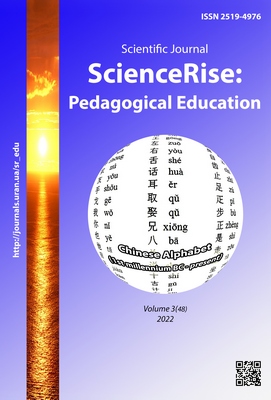Organization of dialogue interaction of adults and children in the developmental environment of early groups
DOI:
https://doi.org/10.15587/2519-4984.2022.257343Keywords:
dialogue, interaction, dialogue interaction, modelling of dialogue interaction, algorithm of construction of dialogue interactionAbstract
The article considers the problem of organizing dialogic interaction of adults and children in the developmental environment of early age groups. The article presents the results of theoretical research on the concepts of "dialogue", "interaction", "dialogue interaction". It is determined, that in most scientific sources dialogue is considered as a form, method and means of social contacts, which is realized by the individual in the subject-subject interaction. Educational influences, focused on dialogic interaction, able to stimulate speech and interpersonal interaction between children, are just beginning to develop and do not have wide practical application. Based on the following ideas about dialogue, the development of dialogical interaction of adults and young children in the educational space of ZDO, it is necessary to focus on solving the following tasks: establishing emotional contact between participants in educational interaction; mastering verbal and nonverbal means of communication; ability to perform actions together with other participants in the educational process. The main models of dialogic interaction, their uniqueness and effectiveness are described, namely: interaction that encourages the child to active cognition (cognitive development occurs during interaction with objects, mastering texts, actions in a specially created space, and the core of such a system is active action ), reorientation of the child's behavior in interaction with an adult (involves natural and logical changes in unwanted behavior of the child, which strengthens the child's sense of self-worth and shapes his/her character; the following types: sandwich, steps, triplets, pattern), supportive interaction task: to help the child to form a positive image of themselves, to realize their value and uniqueness; the following types: emotional, resource, co-existence support). The importance of maintaining consistency in the organization of interaction is emphasized: from the usual way in the usual conditions to the new way in the new unusual space. The algorithm of the organization of dialogue interaction is defined: I look, what the child does now; I feel and analyze what he/she needs now, what he/she expects from me; I give him/her what he/she needs. Emphasis is placed on the importance of compliance with speech strains when interacting with children early, compliance with the rules of communication by all participants in the educational process. Possibilities of application of the offered models of dialogue interaction in modern conditions of reforming of education in Ukraine are defined
References
- Ozadovska, L. (2007). Paradyhma dialohichnosti v suchasnomu myslenni. Kyiv: Parapan, 166.
- Artur, S. J. (1997). The german and russian ideology on M. Bakhtin. London: Routledge, 213.
- Abulkhanova, K. A. (1999). Psikhologiia i soznanie lichnosti. Moscow: Moskovskii psikhologo-sotcialnyi institut; Voronezh: Izdatelstvo NPO «MODEK», 224.
- Volkova, E. N. (1998). Subektnost pedagoga: teoriia i praktika. Moscow, 50.
- Diakonov, G. V. (2009). Osnovy dialogicheskogo podkhoda v psikhologicheskoi nauke i praktike. Kyiv, 573.
- Bekh, І. D. (2003). Vikhovannia osobistostі. Kyiv: Libіd, 344.
- Turek, I. (2010). Didaktika. Bratislava: Iura Edition, 598.
- Nikolaienko, S. O. (2013). Sutnisni kharakterystyky pedahohichnoho spilkuvannia. Pedahohika i psykholohiia. Kharkiv: Skhidnoukrainska orhanizatsiia «Tsentr pedahohichnykh doslidzhen», 96–100.
- Petrovskii, A. V. (1996). Lichnost. deiatelnost. kollektiv. Moscow: Politizdat, 255.
- Levinas, E. (2006). Put k drugomu. Saint Petersburg: Izd-vo S.-Peterburgskogo universiteta, 239.
- Gavrish, N. V., Bezsonova, O. K. (2021). Tekhnologіia stimuliuvannia prirodnogo rozvitku dіtei rannogo vіku. World science: problems, prospects and innovations. Toronto Perfect Publishing, 253.
- Floyd, K. (1997). Communicating affection in dyadic relationships: An assessment of behavior and expectancies. Communication Quarterly, 45 (1), 68–80. doi: http://doi.org/10.1080/01463379709370045
- Weigel, D. J., Ballard‐Reisch, D. S. (1999). The influence of marital duration on the use of relationship maintenance behaviors. Communication Reports, 12 (2), 59–70. doi: http://doi.org/10.1080/08934219909367711
- Kobilchenko, V. V. (2017). Teoretichnі osnovi psikhologo-pedagogіchnogo suprovodu molodshikh shkoliarіv z porushenniami zoru. Poltava: TOV «Fіrma «Tekhservіs», 367
Downloads
Published
How to Cite
Issue
Section
License
Copyright (c) 2022 Natalia Gavrish, Olga Bezsonova

This work is licensed under a Creative Commons Attribution 4.0 International License.
Our journal abides by the Creative Commons CC BY copyright rights and permissions for open access journals.
Authors, who are published in this journal, agree to the following conditions:
1. The authors reserve the right to authorship of the work and pass the first publication right of this work to the journal under the terms of a Creative Commons CC BY, which allows others to freely distribute the published research with the obligatory reference to the authors of the original work and the first publication of the work in this journal.
2. The authors have the right to conclude separate supplement agreements that relate to non-exclusive work distribution in the form in which it has been published by the journal (for example, to upload the work to the online storage of the journal or publish it as part of a monograph), provided that the reference to the first publication of the work in this journal is included.








